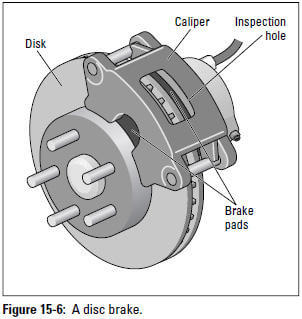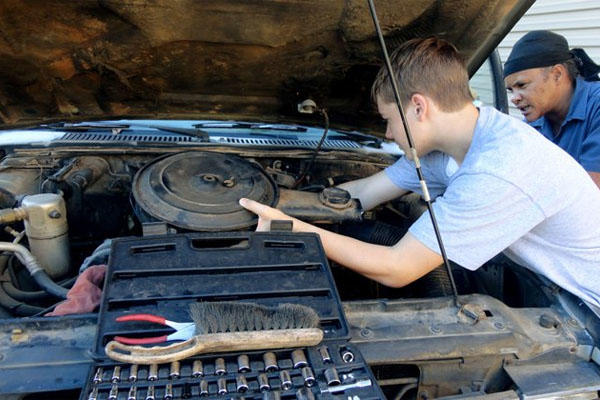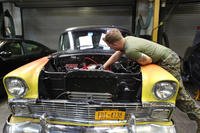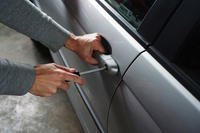Today, most vehicles have four-wheel disc brakes. Others have disc brakes on the front wheels and drum brakes on the rear wheels.
You should check disc brakes (see Figure 15-6) and disc brake linings every 10,000 miles — more often if your brakes suddenly start to squeal or pull to one side, or if your brake pedal flutters when you step on it. Don’t confuse the fluttering with the normal pulsing of ABS brakes when they’re applied inan emergency stop.

Tip: When you check your disc brakes, measure the thickness of the linings on the pads so that you can tell whether the linings on your brakes are badly worn. If the lining is down to the thickness of the steel backing plate, the pads should be replaced.
To check disc brakes, follow these steps:
- Jack up your vehicle and remove a front wheel.
- Look at the brake disc (also called a rotor), but don’t attempt to remove it from the vehicle.
The brake caliper has to be removed before you can remove a brake disc, and the good news is that there’s no need to do so. If you’re working alone, just check the visible part of the disc for heavy rust, scoring, and uneven wear. Rust generally is harmless unless the vehicle has been standing idle for a long time and the rust has really built up. If your disc is badly scored or worn unevenly, have a professional determine whether it can be reground or needs to be replaced.
- Inspect your brake caliper (the component blocking your view of the entire brake disc).
Caution: Be careful. If the vehicle has been driven recently, the caliper will be hot. If it’s cool to the touch, grasp it and gently shake it to make sure that it isn’t loosely mounted and its mounting hardware isn’t worn.
- Peek through the inspection hole in the dust shield on the caliper and look at the brake pads inside (refer to Figure 15-6).
If the linings on the brake pads look much thinner than the new ones you saw at the supply store or dealership parts department, they probably have to be replaced. If the linings have worn to the metal pads, the disc probably has to be reground or replaced as well.
- Replace your wheel, lug nuts, and hubcap, and lower the vehicle to the ground.
If the disc and pads seem to be in good condition and your brake pedal doesn’t flutter when you step on it, you don’t need to do anything else.
Remember: Relining, caliper maintenance, and disc grinding should be left to a professional unless you do the job under supervision at an auto class.
From Auto Repair for Dummies, copyright © 2009 by Wiley Publishing, Inc., Indianapolis, Indiana. Used by arrangement with John Wiley & Sons, Inc.










